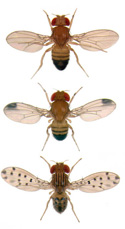Students Travel to Panama for Research Expedition
AUGUST 27, 2009
By Susan Brown
Anybody in here? Looking for fruit flies in a Heliconia flower
The fruit fly Drosophila melanogaster may be the insect counterpart to the lab mouse: so useful a genetic model that it has become ubiquitous in biology labs. But it's just one species of thousands that fit into specific ecological niches by specializing in particular fruits or plants or even mushrooms. "Fruit flies have much to teach us about the genetics of adaptation and the origins of biodiversity," said biology professor Teri Markow. And nowhere is biodiversity greater than in the tropics. Markow has just embarked on an expedition to Panama with a team of undergraduate students from three UC campuses. Follow along as they collect flies, study their ecology, and blog about their experiences.

Examples of the diversity in Drosophila
Credit: Nicolas Gompel
Although the tropics likely harbor a great variety of fruit fly species, relatively few have been collected there and ecological studies are sparse. The students, from UC San Diego, UCLA and UC Santa Barbara, will spend two weeks based in Gamboa, Panama. Already they have set baits of mushrooms and bananas to attract different species.
Stephen Hubbell and Patricia Gowaty of UCLA and the Smithsonian Tropical Research Institute are helping to lead the project. The National Science Foundation's Research Experience for Undergraduates program has funded the trip through a grant to Markow.
